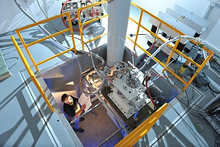Materials research at the Dresden High Magnetic Field Laboratory

Jochen Wosnitza, Dresden High Magnetic Field Laboratory, Helmholtz Zentrum Dresden Rossendorfl, Rossendorf, Germany
In this talk, a brief overview on the experimental infrastructure and the in-house research at the Dresden High Magnetic Field Laboratory (Hochfeld-Magnetlabor Dresden, HLD) will be given. High magnetic fields are one of the most powerful tools available to scientists for the study, modification, and control of the state of matter. The application of magnetic fields, therefore, has become a commonly used instrument in condensed-matter physics and the demand for the highest possible magnetic-field strengths increases continuously. At the HLD, that has opened its doors for external users in 2007, pulsed magnetic fields beyond 90 T have been reached. The laboratory recently has achieved a record field of 94.2 T having the ambitious goal of reaching 100 T on a 10 ms timescale. In the pulsed magnets, a variety of experimental methods are available allowing to measure e.g. electrical transport, magnetization, magnetostriction, ultrasound, ESR, and even NMR with very high resolution. As a unique feature, a free-electron-laser facility next door allows high-brilliance radiation to be fed into the pulsed-field cells of the HLD, thus making possible high-field magneto-optical experiments in the range from 3 to 250 µm. In-house research of the HLD focuses on electronic properties of strongly correlated materials at high magnetic fields. This includes the investigation of novel magnetic materials, the determination of Fermi surfaces of novel superconductors and heavy-fermion systems by means of measurements of magnetic quantum oscillations as well as the recently found evidence for the existence of the Fulde‑Ferrell‑Larkin‑Ovchinnikov state in an organic superconductor.
Site web du groupe de Prof. Wosnitza
Cette conférence est présentée par le RQMP Versant Nord du Département de physique de l'Université de Montréal et le Département de génie physique de Polytechnique Montréal.
Emplacement : Université de Montréal - Pavillon Roger-Gaudry